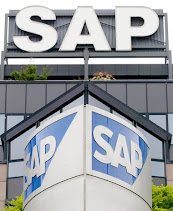Systems Application Production Release / Three Tire Architecture
Leading ERP's ->
Oracle Applications
Oracle Manufacturing
Oracle HRMS
Oracle Finance
High End ERP's -> MNC's.
For MNC's -> SAP R/3, Oracle Applications, People Soft.
Mid Range ERP's - > Small & Medium Scale Company's.
For Small & Medium Scale -> BOAN, RAMCO, JDEDWARDS
Languages Designed by ERP's
SAP R/3 -> ABAP
Oracle Applications -> SQL
People Soft -> People Code
ABAP -> Advanced Business Application Programming
SAP R/3 -> ABAP Language
In this we have 17000 predefined tables.
In this we have 1300 predefined applications.
ABAP Language functionality is
For Modifying predefined applications &
Creating new applications.
SAP R/3 -> BDC
Concept of BDC can transfer the data from Non-SAP to SAP using ABAP BDC.
BDC stands for Batch Data Conversation.
SAP R/3 -> Reports
ABAP Reports is for designing Reports under SAP R/3.
i.e., Extracting Data from data base.
SAP R/3 -> Scripts
ABAP Scripts Provides interface between SAP R/3 and Business Partners.
Prerequisites for SAP R/3
-----------> SQL Statements
-----------> Table Creation in Oracle
-----------> Object Oriented Concept
Hardware Profile
160 GB Hard Disk
1 GB RAM
PIV On Words
Installation Time 42 Hours
In SAP R/3 Leading & Successful Versions
-----------> 4.0 A
-----------> 4.0 B
-----------> 4.5 A
-----------> 4.5 B
-----------> 4.6 A
-----------> 4.6 B
-----------> 4.6 C &
-----------> 4.7 Also called as 4.7 EE (Enterprise Edition)
4.7 is the Latest version of SAP R/3.
In real time environment maximum implementations using 4.6C and 4.7.
Available software’s in SAP R/3
-----------> IDES
IDES is authorized institutes (For Institute Purpose).
IDES stands for International Demo Educational System.
-----------> Production Software
Production Software is for Organizations.
History of SAP R/3
SAP R/3 is the product of SAPAG (AG stands for LTD)
* SAPAG is a German based organization.
* SAP R/3 is released in 1992.
* SAP R/3 can work based on RDBMS.
* ABAP Language designed based on ' C ' Language.
Advantages of SAP R/3
* Platform independent.
* Even it’s a Database independent.
Under SAP R/3 Projects
--------> As an ABAP Programmer
1. Life Cycle Implementation
* Also called as End-To-End Implementation.
* Implementing SAP R/3, all new implementations are the part of "Life Cycle Implementation".
2. Upgradation
* Upgradation is upgrading version to version.
i.e., 4.0 A to 4.7
3. Support
* Support means modification in existing objects.
ABAP Methodology
Using this method we developed in SAP R/3.
Methods are
-------> Accelerator SAP
-------> SAP Solution Manager
SAP R/3 -> RFC
* RFC Stands for Remote Function Call.
* RFC Provides interface across SAP R/3 Systems.
SAP R/3 -> BAPI's
* BAPI's stands for Business Application Programming Interface's.
* It provides interface between SAP R/3 with Non-SAP front ends.
SAPAG
/ \
SAP R/3 New Dimensional
\
-> SAP-BI or BW (Business Warehousing Product)
-> SAP-Netweaver (Web Based)
-> ECC ( Enterprise Central Component)
7.0 is the latest version of ECC.
